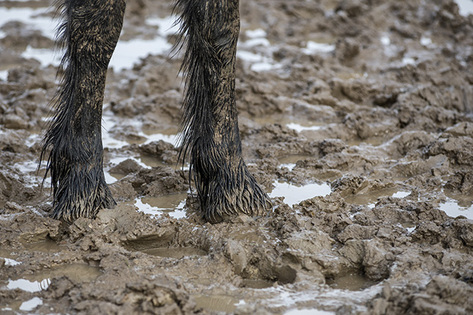
Ad-Lib vs Trickle Feeding - What's Best For Your Horse?
Equestrian Advice & Guides Beginners Advice
Build your business profile for FREE and expose your services to thousands of potential clients!
Create my profile now!
Each winter that arrives seems to be wetter, making the management of horses increasingly difficult. One of the biggest challenges of a wet season is the management of grazing and turnout.
With increased rain comes increased mud, often making turnout impractical or impossible at some yards, despite the best attempts of the yard owner. Many yards bring in turnout restrictions or stoppages in times of severely wet weather, which can be difficult and disappointing for horse owners who want their horses out stretching their legs and grazing in the fresh air. Having horses in for a large portion of the day can be hard work, leading to increased forage and bedding costs, more mucking out, and worst of all, stressed horses who want to stretch their legs and blow of some steam with their friends in the field.
What many horse owners don’t understand is that by restricting turnout, yard owners are simply trying to protect the grazing in order to ensure the paddocks will be able to support grazing during the following spring, summer and beyond, whilst also ensuring the safety and wellbeing of horses in their care. To fully understand the reasons behind restricting grazing, horse owners must first understand the complex management invloved to ensure land can sustain horses year-round. Damage to paddocks in the winter months can not only ruin the grass but can also damage the soil as well, meaning fields can take months, even years, to recover and provide sustainable grazing again.
Managing grazing and the condition of their paddocks is a huge part of a yard owners livelihood. Being unable to provide this as part of their livery package can be hugely detrimental to the number of horses their yard can sustain, and ultimately their income. Additionally, turning horses out in muddy paddocks has been proven to increase the risk of issues and injury, from strains and mud fever to loosing shoes and squabbles at the gate. The rain will also make ground slippery and dangerous, both in fields and on tracks, creating an increased safety risk for the horses and those those handling them around the yard.
Yard owners do not want horses to be confined to their stables 24/7 and will not take this decision lightly. This potentially results in horses that are harder to handle, increased yard work and unhappy owners. You also need to consider the extra work that a yard owner and their staff have to put in to deal with wind, rain and mud, to ensure the care of the horses, whatever the weather. Unfortunately, many horse owners do not take the time to fully consider the reasons a yard owner might restrict grazing and will be unhappy about the situation, with many even chosing to 'jump ship' to another yard where they appear to offer grazing regardless of weather or ground conditions.
Unfortunately, this can often be a huge mistake, as those yards who allow grazing year-round on wet ground will often be the ones who are then unable to offer sustainable or good quality grazing in the summer, due to the damage sustained by poaching over the winter. Whilst a yard offering winter turnout can seem appealing in the short term if your horse is on restrictions, it's worth fully considering the future implications of any move, especially if a new yard may be about to bring in restrictions themselves!
Due to the increasingly wet winters, many yard owners are changing their routines, reducing paddock sizes to reduce the poaching of land, and some are even investing in creating all weather turnout paddocks or improving gateways and pathways on the yard to help alleviate the situation during reduced turnout.
All yard owners will want horses to be out; it's far easier for them, and the interest of the horses will always be their prime concern, which is what horse owners must realise. You are far better off discussing with your yard owner how best to deal with the situation, and supporting their decisions rather than reminding them constantly about the mud and turnout, of which they will already be very well aware!
So, if your yard has brought in turnout restrictions, how can you work with your yard owner to make life easier for everyone, and to best handle the situation when it comes to the management of your horse?
Communicate with your yard owner - Most yard owners should have a plan on the turnout, and will no doubt be trying their hardest to ensure the horses can go out as often as possible. However, weather is unpredictable, and even a nights heavy rainfall can change the best laid plans from the night before. A yard owner has to make a decision based on what they feel is best for the horses on that particular day. They should keep you informed and, where possible, you should ensure you are prompt at responding and following requests.
Find solutions to break up your horses day - Perhaps your yard owner is happy for a small paddock to be used for horses to be turned out briefly whilst mucking out, perhaps there is a horse walker that can be used, or an area of hardstanding or an all weather arena that can be used to allow the horses just to stretch their legs. Even if you have a horse that is unable to be ridden, you can lead them in hand; simply taking your horse out of the stable and tying them up elsewhere for a good groom can help break up the day for them.
Stick to the rules - If your yard owner has asked you not to turn out, or only to use certain paddocks, then this is what must be done. The infringement of yard rules makes life much harder for any yard owner, and can potentially affect other liveries too. Trying to force extended grazing upon your yard owner is unfair; you should be respectful that the yard is their business and income, and they are only acting as they see fit to preserve grazing for the coming months. At the end of the day, your horse may be just as miserable stood fetlock deep in mud, in the cold wind and rain than it would be warm and dry in its stable.
Exercise your horse - Horses on restricted turnout will benefit hugely from regular exercise. Unfortunately, many riders are reluctant to exercise their horses in wet weather which is understandable, but a lack of exercise combined with a lack of turnout can result in stressed horses and in turn can lead to a change in their behaviour, both in hand and under saddle. Adequate exercise will allow them to stretch their legs, exercise their body and mind, as well as helping keep them in good condition. Even a 10 minute lunge or leading out in hand each day can alleviate their boredom and be beneficial for their mental well-being.
Change your stable management to reduce time and costs - If horses are in all day, it often means you need to muck out and refresh bedding more often. It’s worth considering altering your stable management in order to reduce the work and the amount of bedding you need; things like leaving a reduced bed during the day, deep littering or introducing rubber matting can make a big difference. Also, horses do not need huge haynets that end up being thrown on the floor, mixed with bedding and end up on the muck heap. Horses are trickle feeders, so it’s much better to give them several smaller haynets throughout the day, rather than one huge one.
Keep your horse entertained - There are numerous stable toys available to keep your horse entertained during periods of stabling. You can even create ‘boredom breakers’ yourself by hanging their favourite vegetables from strings, or placing multiple smaller haynets around their stable. Anything that encourages a horse to keep moving around their stable will be beneficial to them, as this naturally encourages bowel movements and can reduce the likelihood of digestive issues during long stabled periods.
So, if your yard brings in turnout restrictions when the rain is torrential and the ground is wet, consider the full implications and reasoning for such actions. Work with your yard owner to help make the time easier, as this will only make life better for everyone!
LiveryList is the UK’s #1 Livery Yard Directory. As well as a comprehensive database of yards across the UK, it also offers support and advice on all practical and administrative aspects of yard management. LiveryList also runs a popular support group on Facebook - Livery Yard Owners UK- Discussions and Advice - open to all yard owners.

